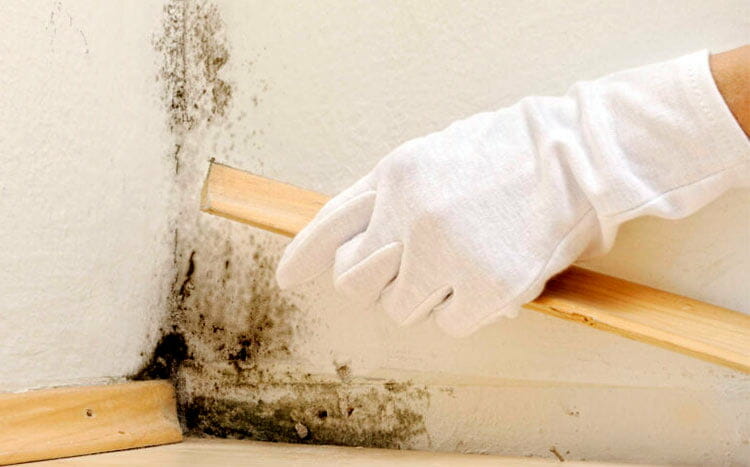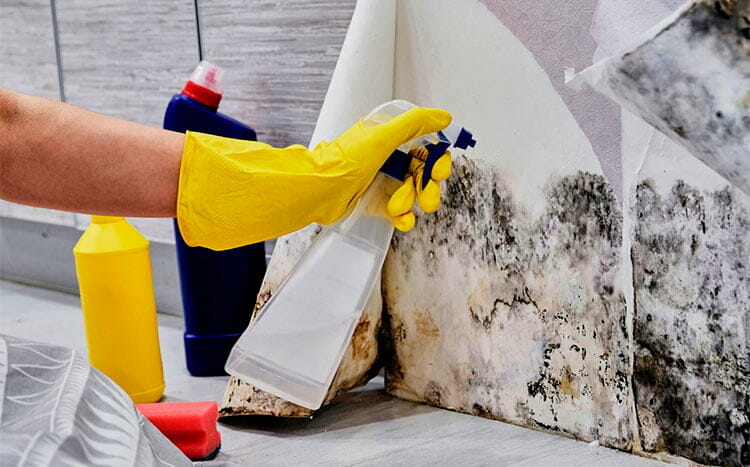Basements becoming moldy is a frequent issue for structures situated in damp or humid climates, places that are at or beneath sea level, and comparable settings. Nonetheless, without adequate waterproofing actions implemented during the building phase, the majority of basements are susceptible to moisture-related problems.
To get rid of mold in the basement, you need to first spot and repair all known sources of moisture, then remediate mold by removing all visible mold. Lastly, you will need to prevent any future leaks or damp issues that may lead to mold returning.
Removing mold from basements is a challenging and dangerous job. Ensure that you have the proper protective equipment to avoid mold exposure.
5 Steps to getting rid of basement mold
Mold growing in basements can be removed, either as a DIY project or by a professional mold remediator, if the mold growth area exceeds ten square feet (three meters). Do not remove the mold if there is considerable water damage in your basement. If you are unsure of what to do, the U.S. Environmental Protection Agency (EPA) Mold Remediation in Schools and Commercial Buildings guide is an excellent resource on remediating mold damage caused by water in all building types.
Below are the steps involved in basement mold remediation.
Step 1. Put on protective gear
Wear the following protective clothing to avoid exposure when cleaning basement mold.
- Old clothes that cover your arms and legs.
- A pair of gloves to protect your bare hands from direct contact with mold. Wear long forearm length rubber or PVC gloves to protect your skin from bleach and other strong chemicals used to clean mold.
- An EPA-approved respirator to avoid inhaling mold spores. Respirators or dust masks are available at hardware stores, and they range in types, sizes, and functions. Occupational Safety and Health Administration (OSHA) regulations require that you wear a respirator that fits properly.
- A pair of goggles without ventilation holes to protect your eyes from airborne mold spores.

Step 2. Dry the basement and fix the moisture problem
The next step is to dry out your basement completely. Mold growth is a direct consequence of moisture, and if you don’t resolve the moisture problem, mold will return to the cellar after remediation. You can do that by doing the following:
- Dry out your basement by installing a dehumidifier to remove the excess atmospheric moisture (humidity) on the walls.
- Identify and fix the source of moisture. Check the pipes running through the basement for leaks, repair broken basement windows, and damaged window seals.
- Get rid of water collecting around your home foundation by clearing clogged drains and diverting roof gutters away from your building foundation.
- The condensation in your HVAC system will find its way into the basement through leaking pipes. Check the pipes for leaks, and have a professional repair it if there is one.
Step 3. Remove all mold-damaged items from the basement
Permeable (porous) materials absorb mold spores which makes them challenging to remediate. The best idea is to remove all mold-damaged porous items and cellulose-based materials from your basement.
Examples include:
- Ceiling tiles.
- Drywall.
- Insulation.
- Wooden furniture, wood frames, and other wooden items.
- Moldy carpets (soaked musty carpets should be promptly disposed of)
- Leather items.
- Cardboard boxes, papers, and damp books.
Mold damaged high-value or sentimental items such as paintings, family pictures, rare books and manuscripts, expensive carpets, luxury leather luggage, wooden sculptures, and antique wooden furniture can be removed and sent for repair and restoration by a specialist.
Note: mold-damaged upholstered furniture can be reupholstered and put back to use.
Step 4. Clean the mold
Now, it is time to clean mold from growth areas and non-removable items in the basement. There are different techniques for cleaning moldy surfaces. However, cleaning mold with brush/disposable sponges and cleaning agents will remove the most mold without spreading to other parts of the house. You can only perform this step when steps 1-3 are accomplished.
- Moisten dusty mold with liquid from a spray bottle before cleaning to prevent dry mold spores from being airborne.
- Using a spray bottle, apply a detergent or chemical/organic mold cleaner on areas with visible mold and allow it to soak for ten to fifteen minutes.
- Use a bristle brush or disposable rags/sponges, depending on the surface, to scrub/wipe mold. Rinse your brush/rag repeatedly in clean water to avoid spreading mold to other surfaces.
- You can clean mold on carpeting with a vacuum cleaner equipped with a HEPA filter to keep mold spores from spreading to other parts of the building.
- Rinse cleaned surfaces with clean water and wipe them down with a clean paper towel.
- Wait for the surface to dry and inspect for residual mold particles. If you see any, repeat the cleaning process.
Step 5. Confirm the success of the mold cleanup
The last step in the mold rival process is probably one of the most important because this is when you can know for sure if the mold is gone and won’t return. Some homeowners invite a mold inspector to take air particle samples to check whether the mold has returned to acceptable levels. Another option is to visually look for signs of mold and confirm if the repairs on water pipes or other sources of moisture are holding up.
Use this FREE service
HomeGardenGuides.com is a free service that quickly matches you with top-voted local mold removal Specialists.
You can get three estimates fast by real certified experts in your area in just 2 minutes.
- Scroll to the top of the page and enter your Zip code.
- Answer questions about your mold removal job
- Your project details are forwarded to three local experts. They will send you a price estimate for the job and some friendly advice.
IMPORTANT: There is no obligation to hire. This is a free tool and service to be used at your pleasure.

How do I get rid of mold in the basement without using chemicals?
Mold remediation companies often use a variety of commercial chemicals to remove basement mold. While these products are effective, they can be toxic to humans. Chemical mold killers also have adverse effects on the environment, which makes them more dangerous than mold. Several non-toxic substances can kill basement mold just as efficiently as hazardous chemicals. Natural mold killers are environmentally friendly, and they are totally safe to use around pets and children.
Vinegar
You can use vinegar to kill 82% of mold species, including the dreaded black mold. Vinegar can kill mold on both porous and non-porous surfaces. Although vinegar has an unpleasant smell, it is children and pet safe. You can use 5% vinegar to clean most basement mold. 20% vinegar should be used for more severe mold problems.
Baking soda
Baking soda performs a double function of killing basement mold and absorbing the moisture that causes mold. Baking soda is an abrasive mold cleaner that effectively kills mold when mixed with a measured quality of water, sprayed on moldy spots, and scrubbed with a brush. You can combine baking soda with vinegar and water to create a thick paste that will kill all the black mold growing in your basement.
Essential oils
Essential oils are sweet-smelling compounds that also double as efficient basement mold killers. Essential oils are naturally secreted, and they contain a range of lethal antimicrobial compounds that can eradicate most mold species. Essential oils remain one of the safest ways of killing mold and preventing the return of mold spores to remediated areas.
What tools do you need to get rid of mold in the basement?
You will need different tools to perform a DIY basement mold remediation successfully. They range from protective gear to items used to clean mold. Below is a list of essential equipment needed for basement mold remediation:
A respirator: you need a respirator or dust mask to avoid breathing mold spores into your lungs. A NIOSH-approved reusable respirator equipped with a 100 level particulate filter provides the best protection against airborne mold spores during mold remediation.
Goggles: non-vented safety goggles are designed to protect the wearers’ eyes from contact with airborne mold spores.
Gloves: disposable or reusable rubber or PVC gloves keep your hands from touching mold and protect your skin from the toxic chemicals used to clean mold.
Handheld spray containers: you can effectively direct mold cleaners inside spray containers at mold spots, making removing mold a lot easier. Spray containers also allow the efficient discharge of mold cleaners in small squirts and help homeowners save costs.
Wire or hard-bristle brush: can be used for scrubbing moldy surfaces. They are also effective at getting mold out of rough surfaces and dislodging mold particles from cracks and crevices.
Cleaning agents: household detergents, mold-killing chemicals, and natural mold cleaners such as vinegar are the essential tools you will need to remove mold. Most cleaning agents are available in stores as ready-to-use commercial products.
Buckets: cleaning buckets with graded measurements allow you to mix bleach and other mold cleaning solutions in precise quantities. It prevents the oversaturation of chemicals that may be too weak to kill mold.
Rag/sponge/paper towels: are required to wipe the mold off surfaces. It is best to use disposable rag/sponge/paper towels and ensure that you dispose of them properly after use.
Vacuum with HEPA filter: a HEPA fitted vacuum cleaner is used to scoop mold sores from carpets and other dry surfaces. This device reduces the risk of mold spores spreading into other areas of your home.
Mold test kit: allows you to collect samples from around your basement before and after mold removal. A lab report from the sample collected gives you a reading on whether you have mold and the type of mold species present in your basement.
A determined spirit: removing mold from your basement is a mind-numbing, tedious, and, lest I say, a very tiring task. It will help if you have plenty of energy, commitment, and a strong desire to see the project to the end. A determined spirit makes all the difference between a finished DIY mold removal project and an abandoned one.

DIY vs. Calling an Expert
Getting rid of basement mold is a job that both professionals and amateurs alike can handle. However, there are limits. The EPA guidelines for removing mold clearly state where DIY mold removal stops and when professional mold remediation should start. Ignoring EPA guidelines can make a bad problem worse and may result in extensive mold contamination.
Do it Yourself
DIY removal of mold growing in basements is a precarious venture, and it should be undertaken where there are small amounts of mold growth and only when necessary. Moreso, you need to have the experience to remove mold without contaminating your entire house and the skills to perform repairs on mold-damaged materials, such as drywall. Do not remove mold caused by sewage or contaminated water; you should leave those for the big boys.
Pros
- DIY mold removal is cheaper than hiring a professional.
- DIY mold removal allows you to develop household skills that can be useful during other home improvement projects.
- You may spot issues in your basement or foundation that can turn out to be a much bigger and expensive problem if undiscovered.
Cons
- You may fail to resolve the underlying cause of mold.
- There is a higher risk of mold contamination when you remove basement mold by yourself.
- The odds of unintentional exposure to mold spores are higher.
- You may fail to remove all the mold due to a lack of experience and equipment.
Calling an Expert
Hiring an expert to remove basement mold is the safest way to get rid of mold without endangering your health and those of your family and neighbors. Professional mold remediators have the experience and equipment to tackle severe mold infestations that will overwhelm your average DIY guy.
Pros
- A professional will identify and repair the source of moisture causing the mold.
- A professional will offer advice on the best approach to tackle the mold problem and give you tips on preventing the return of mold.
- A professional can also perform related repairs at little extra cost.
- A professional mold remediation job is a seal of quality that gives you leave of mind and adds to your home value.
Cons
- Professional mold remediation is expensive.
FAQ's
What causes mold in the basement?
Moisture is the primary cause of mold and mildew in basements, and cellulose-based materials like wood or paper provide food for mold. Where these two factors exist, then mold presence is inevitable. Mold can start growing on damp spots between 24 – 48 hours. Leaking pipes, condensation from HVAC systems, floodwater, and other sources of moisture provides prime conditions for the growth of mold. Drying out moisture promptly is the most effective way to prevent mold.
Is mold in my basement dangerous?
Stachybotrys chartarum is a species of black mold that commonly grows in basements. It is a dangerous mold species that produces mycotoxins. Mycotoxins are harmful, and they cause several illnesses and medical issues in humans.







